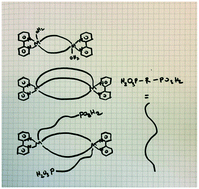Mimicking cellular phospholipid bilayer packing creates predictable crystalline molecular metal–organophosphonate macrocycles and cages†
Abstract
We report a novel mechanism to create a predictable molecular metal–organophosphonate cage [Zn2(2,2′-bpy)2(H2ODP)2(H4ODP)]·2H2O (1·2H2O) (H4ODP = 1,8-octanediphosphonic acid) and a macrocycle [Cu2(2,2′-bpy)2(H2-1,4-NDPA)2(H2O)2]·H2O (2) (H4-1,4-NDPA = 1,4-naphthalene diphosphonic acid). The structures were solved using single crystal X-ray diffraction. The photoluminescence properties of 1·2H2O, investigated both in solution and in the solid-state at room temperature, indicated that the tighter zinc binding in the solid state leads to the augmentation of fluorescence. The ORCA molecular structure optimization calculations for 1·2H2O suggest a slight opening of the cage structure in non-polar solvents while in polar solvents the cage is tightened. Toxicity analysis with Caco-2 cells indicates that the molecule is readily tolerated by intestinal cells.



 Please wait while we load your content...
Please wait while we load your content...